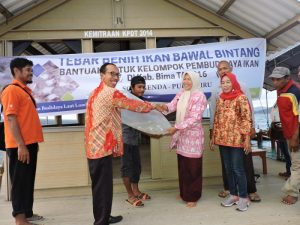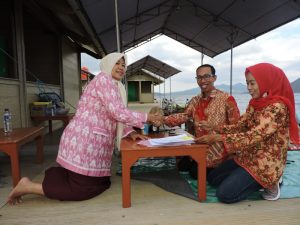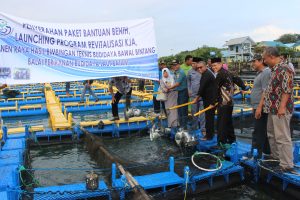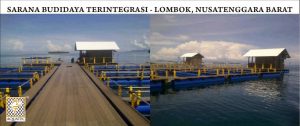The Marine Cultivation Association (BBL) of Lombok is one of the BBL Lampung development station in 1992 with the assignment of developing marine cultivated fishery in Nusa Tenggara Barat. This association was built in the coast of Gerupuk Bay, Sengkol Village, Pujut Sub-district, Center Lombok District of NTB. Considering the growing demand of the task and function, and the ease of marine cultivation development in NTB and its surrounding areas, in 1994 the station status was upgraded into Lombok Marine Cultivation Center (LBL-L). Various tools and facilities were improved to support marine cultivation development, and in 2000, along with the birth of the Department of Marine and Fishery Exploration, Marine Cultivation Center under the supervision of the Directorate General of Cultivated Fishery received an upgrade in budget and production tools in Gili Genting, West Sekotong Village, Sekotong Sub-district, West Lombok District of NTB. The Lombok Marine Cultivation Center status was again upgraded into Lombok Marine Cultivation Association in 2006 as one of the Technical Implementation Unit (UPT) of the Directorate General of Cultivated Fishery under the Department of Marine and Fishery in the area of marine cultivation, based on the regulation of the Ministry of Marine and Fishery NO.PER.10/MEN/2006. BBL Lombok is tasked with implementing seawater fish hatchery and cultivation techniques, as well as preserving the parent/seed resources and the seawater fish environment.
Lombok Marine Cultivation Association (BBL) located in Sekotong is one of 15 technical implementation units across Indonesia, under the Directorate General of Cultivated Fishery of the Ministry of Marine and Fishery. BBL Lombok is capable of producing fin fish seeds such as humpback grouper, brown-marbled grouper, and snub-nose pompano for cultivators as well as consumptions in NTB, NTT, and Bali. BBL Lombok also provide assistance in the cultivation of lobster, abalone, seaweed, and pearl.

TRACHINOTUS BLOCHII
While humpback grouper requires 18 months’ cultivation period, brown-marbled grouper requires about one-year time. This fish can be a prime commodity for export to Hong Kong. Meanwhile, the snub-nose pompano, although considered a new species in Indonesia, has started to be well known among the people and has become a prime commodity with high demand both in domestic market and for export. Snub-nose pompano becomes a highly demanded commodity to supply the ever-growing restaurant businesses. This fish is highly sought for consumption due to its omega-3 content which is good for body growth. In Lombok alone, regular demands always come from Bali as the main market, and also Java and Jakarta. Although the price of snub-nose pompano is lower than grouper, due to its shorter rearing period, this Taiwan originated fish is quite in demand among cultivator societies. Aside from its shorter rearing period, snub-nose pompano is also obtainable domestically. The cultivation of snub-nose pompano should follow the guidelines of CBIB (proper fish cultivation technique) in order to achieve optimum yield. Currently, there is an SNI (Indonesian National Standard) for snub-nose pompano hatchery, synthetic feed for the fish, and the rearing technique in floating marine cages.
The snub-nose pompano cultivation method in floating marine cages begins by using good quality seeds according to SNI standards. The seed measurement, at least 80% of the seed population being distributed to the rearing area, must be uniform. There are few steps in snub-nose pompano cultivation technique. These steps are necessary to avoid the usually high mortality rate. The fish are selected based on their sizes in order to avoid cannibalism, and for uniform growth in order to achieve uniform yield as well. In terms of cultivation, there are three phases; spawning, nurturing, and rearing, given the snub-nose pompano seeds come from the hatchery or seed center.
Spawning must be done specifically in controlled tubs or in specific floating marine cages. The density of snub-nose pompano seed distribution in should be 70-80 fish/m3. After keeping them for 1.5-2 months, the density should be reduced to 60-70 fish/m3, until the spawning period reach 2-3 months. During the spawning phase, the feed size given to the fish must be adjusted the width of the fish mouth opening. The feed is in the form of pellets and rough fish in fresh condition and milled for feed. The frequency of feeding is 4-6 times a day, then later on, twice a day which is in the morning and afternoon.

The next step is the nurturing process, in which the snub-nose pompano pre-fingerling is distributed to floating marine cages with a density of 60-70 fish/m3. During this phase, the snub-nose pompano is given feeds in the form of pellets or fresh rough fish, chopped into tiny pieces according to the width of the fish’ mouth opening. The feeding frequency is at least twice a day, in the morning and afternoon. In addition, the fish are also given additional vitamins once a week, together with the feeds. To ensure sufficient feeding, it is recommended to feed the fish until they are completely full.

The last step is the rearing phase, usually after 2-3 months of nurturing in floating marine cages, when the fingerlings have reached the size of 70-80 grams/fish. The fish can then be transferred to the rearing floating marine cages. The density of fish distribution inside the rearing floating marine cage should be between 40-50 fish/m3. During the rearing process, the fish are also given fresh rough fish as feeds. They are fed twice a day, in the morning and afternoon. In this phase, the fish are also given additional vitamins once a week, mixed with the feeds. Usually, within 5-6 months in the rearing floating marine cage, the fish would reach the size suitable for consumption. Snub-nose pompano can reach a weight of 700-900 grams/fish after 5-6 months rearing process.

In snub-nose pompano cultivation, transferring the fish to floating marine cages should be done in good weather condition and stable tides. When the weather and wave are stable, the survival rate if this fish is considerably high, which is around 70-80%. Snub-nose pompanos are vulnerable to death when exposed to wave crashes. Aside from the wave, the fish must also be kept away from possible virus or parasite attacks. Therefore, the marine cages must be replaced monthly to keep the water circulation smooth and to maintain the water quality.

Seawater fish cultivation techniques in BBL Lombok has been utilizing modern floating marine cages. BBL Lombok trusts Aquatec HDPE floating marine cage for snub-nose pompano cultivation. The Aquatec floating marine cages has good quality and durable construction to withstand the ocean waves. It also uses environmentally friendly HDPE material, with a lifetime of more than 25 years, and easy maintenance. The use of Aquatec floating marine cages also gives more optimum yield for the cultivators, hence it improves the welfare of cultivator societies. BBL Lombok recommends the use of Aquatec floating marine cages to new cultivators because it is advanced in quality and technology, economical, and domestically made.












